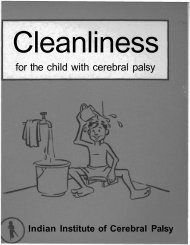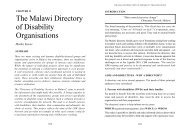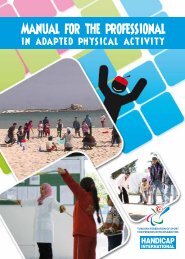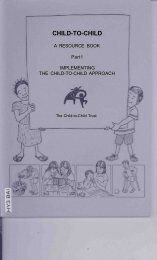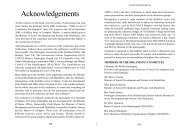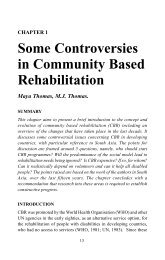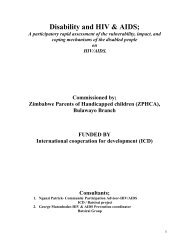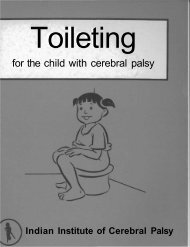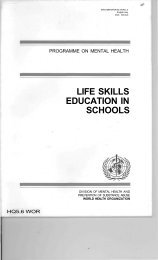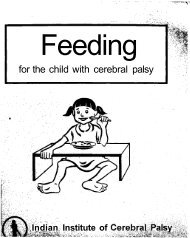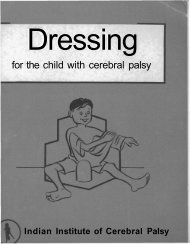CBR AS PART OF COMMUNITY DEVELOPMENT - Source
CBR AS PART OF COMMUNITY DEVELOPMENT - Source
CBR AS PART OF COMMUNITY DEVELOPMENT - Source
You also want an ePaper? Increase the reach of your titles
YUMPU automatically turns print PDFs into web optimized ePapers that Google loves.
<strong>CBR</strong> <strong>AS</strong> <strong>PART</strong> <strong>OF</strong> <strong>COMMUNITY</strong> <strong>DEVELOPMENT</strong><br />
EDITORIAL<br />
Maximising an individual's potential to perform activities related to dailyliving,<br />
participation and inclusion, may be potentially important mechanisms<br />
within <strong>CBR</strong> for achieving the goal of an improved quality of life. Chapter<br />
4 highlights this point in relation to the realities of economic empowerment<br />
and the need for disabled people to take responsibility for their own<br />
development and integration into society. Man can only liberate himself,<br />
he cannot be liberated by others. Maximising full potential through a<br />
rehabilitation process could be seen as part of this process. This<br />
observation and argument led to another key message of the conference,<br />
that "<strong>CBR</strong> should promote rights but also it should promote<br />
responsibilities."<br />
The African groups are not alone in their difficulties with including<br />
'rehabilitation' as a useful 'ingredient'. The 'R' of <strong>CBR</strong> has been the<br />
source of many discussions and debates summarised by Miles (1996).<br />
However representatives from the world <strong>CBR</strong> community in Helskinki<br />
(WHO 2003) agreed that, to change the name of <strong>CBR</strong> at this stage (two<br />
decades after its inception) would not be productive. A more constructive<br />
way forward is the realisation that the rehabilitation process can apply<br />
to the community as well as the individual and that <strong>CBR</strong> has an important<br />
role to play in "rehabilitating the community". Social integration, inclusion<br />
and awareness raising are, in reality, strategies for "rehabilitating the<br />
community". This perception does much to vindicate the use of<br />
"rehabilitation" within the title of <strong>CBR</strong>, and is discussed in Chapter 2<br />
with many examples from different African countries of how this has<br />
already been done.<br />
If this argument still remains illusive to the reader, there are many other<br />
"R" words that might reflect good practice and important dimensions of<br />
the <strong>CBR</strong> ideology, such as, "Rights" "Responsibility" "Regular contact"<br />
"Regard" "Reflection" "Resilience" "Relations" "Rejuvenation" and<br />
"Resolution". It would appear that rehabilitation of both the individual<br />
and the community have an important role to play in a comprehensive<br />
(rather than a medical OR social OR rights) approach.<br />
WHAT THIS BOOK <strong>OF</strong>FERS<br />
This book provides a reflective piece of work that can be used as a basis<br />
for future action throughout the African continent. The contents not<br />
only provide an overview of present day <strong>CBR</strong> knowledge, but show<br />
how this information has been interpreted and implemented in the African<br />
context. The writers are predominantly of African origin and they ably<br />
provide a clear view of the "state of the art" of <strong>CBR</strong> in many parts of<br />
their continent. They provide examples of their own <strong>CBR</strong> experiences<br />
and case studies of their programmes, the problems they faced and how<br />
they were overcome. This is therefore another positive step in the journey<br />
of African people to share their own experiences and develop their own<br />
solutions to their problems within the context of their own cultural<br />
perspectives.<br />
The 12 key messages from this conference are listed in Appendix 3, and<br />
give readers the opportunity to evaluate their own activities against these<br />
messages. For example they might ask themselves: does our <strong>CBR</strong><br />
programme address poverty? If so how? If not, how could it address<br />
this problem in a practical way? To what extent is our <strong>CBR</strong> programme<br />
pro-active? How could this be improved? How do we include disabled<br />
people in the planning and implementation of our programmes? Do we<br />
make special provision and effort to include deaf people? If not, how<br />
can we improve this? etc., etc.<br />
The book also offers discussion questions in Appendix 2 that could be<br />
used for conferences or workshops, or as a basis for discussions in <strong>CBR</strong><br />
training programmes. They can be used to develop a more in-depth<br />
understanding of the situation in which people are working and help them<br />
to develop their own solutions to the problems that they are facing.<br />
Finally, at the end of each chapter, the book provides a source of<br />
references to the academic literature. In addition, Chapter 11 provides a<br />
list of useful web sites and unpublished documents can also be found.<br />
This information can be used by practitioners all over Africa to access<br />
more information about services and support for people with disabilities.



